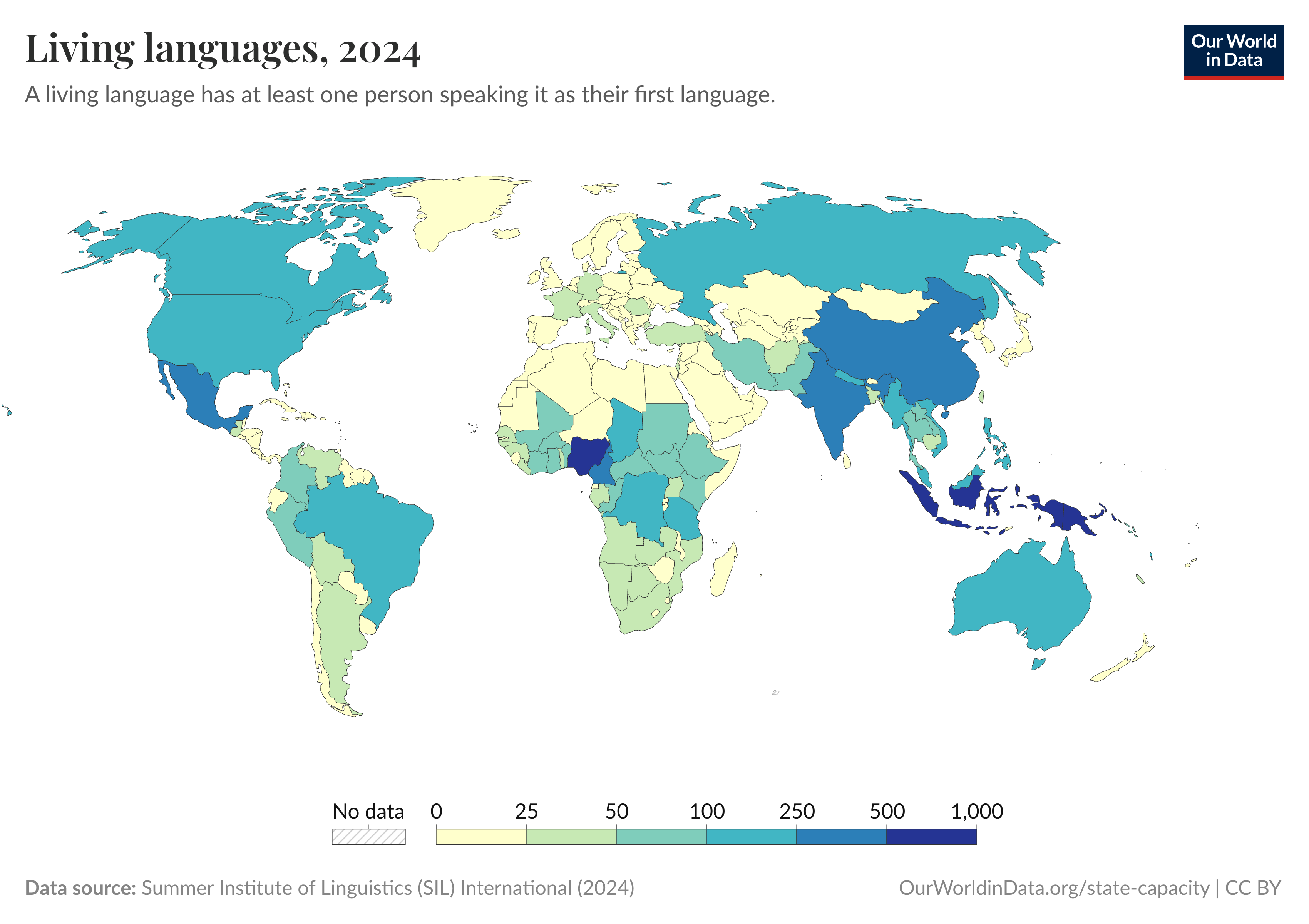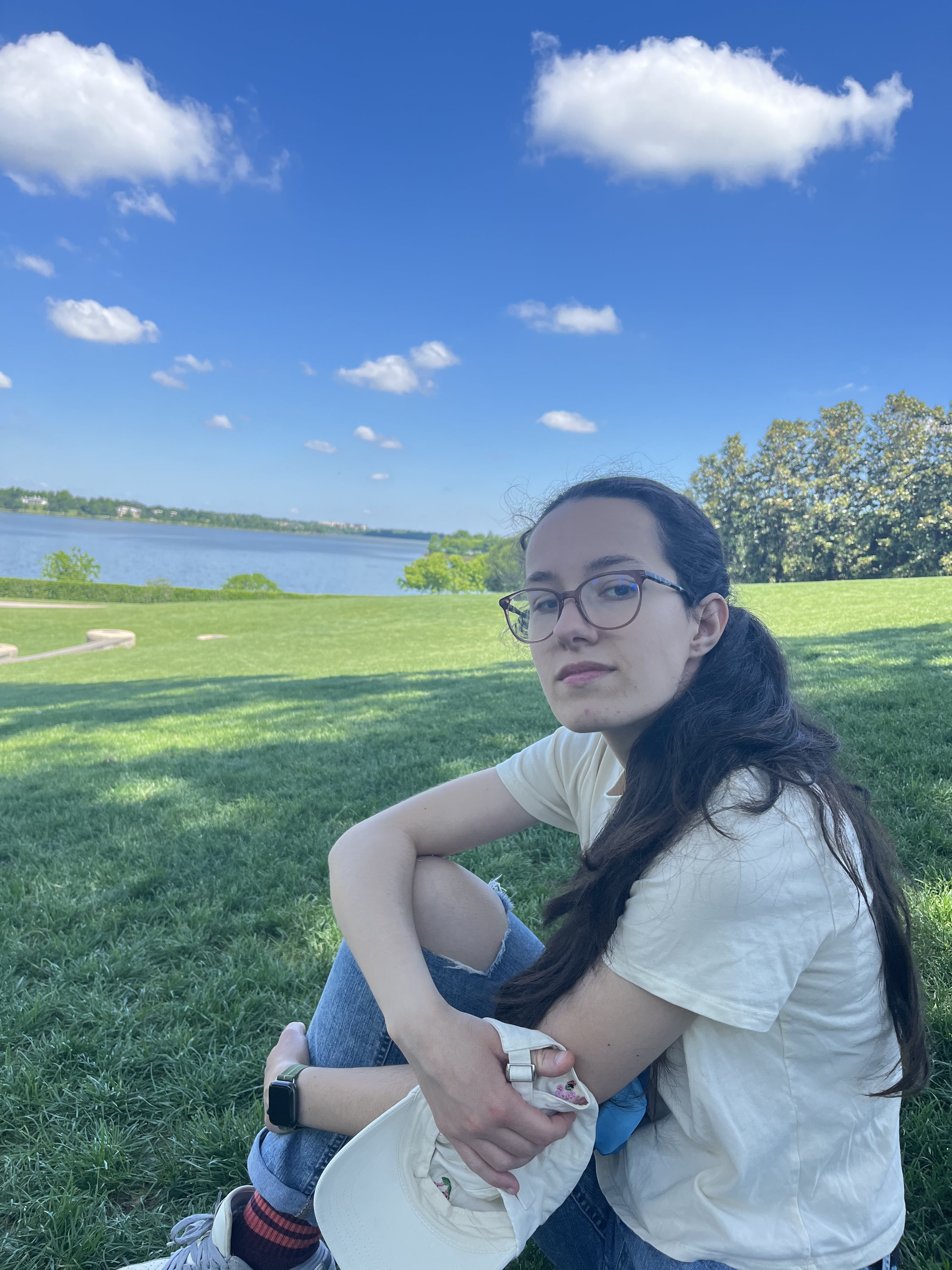A Thousand Songs
A Thousand Songs
The world has around 7,900 languages, but you are likely to only listen to music from a handful of them. Across the top 10k global songs, 4 languages: English, Spanish, Hindi and Korean make up 75% of all languages sung. These big languages are spoken by billions of people across the world. They are the institutional languages used in official documents and they’re designated as the standard language in the countries they are spoken. In other countries, people learn them through culture and media.
While languages like English and Spanish have billions of speakers, many languages outside of the most widely spoken ones are small, spoken by only hundreds of people. These languages are often not studied at schools, not used in official documents and not well-preserved. They are often found in remote areas of the world: in fact, the region with the highest amount of linguistic diversity in the world is Papua New Guinea, where linguists have identified 800 different languages.
Other remote countries, like Vanuatu, or very big states, like Nigeria and India, lead the world for number of languages spoken (source: Summer Institute of Linguistics (SIL) International (2024) – with major processing by Our World in Data):

In Papua New Guinea and across the world, linguistic diversity is on the decline. Out of all the world’s languages, 41% are endangered and 6% (or around 450) are considered extinct. Source: Ethnologue. Languages go extinct when there are no living speakers and no one retains a sense of ethnic identity associated with it.
As a side effect of this linguistic loss, it’s usually pretty difficult to find any information about dead languages online. ISO, the International Organization for Standardization, update their classification of languages online every year to reflect changes such as a language going extinct. For Tandia, an Austronesian language which went extinct in 2024 when the last of its 2 speakers died, I could not find any recordings of people speaking it online. No records, spoken or written, means a language has vanished. Music, on the other hand, can serve as a way to preserve a language and its stories. Inspired by this, I decided to do a project: I would collect and create a playlist of songs from all over the world. Specifically, I decided to source 1,000 songs from 1,000 different artists each speaking different languages. My hope is that this playlist would capture some of the world’s diversity in languages and in music styles.
First, some notes on methods. There is no consolidated dataset of singers and languages they sing in, so I set to extract that information from wikipedia. Using Wikidata, wikipedia’s own structured query language and python’s pycountry library, I queried info for singers of 7.9k world languages. After a couple hours of running my code, this process yielded around 5,000 people but only 161 unique languages. This was okay but far off from 1,000 languages. I decided to use some heuristics: if I wasn’t going to be able to explicitly link singers to languages they use, maybe others had already done some of that work for me. I turned to Spotify to search for playlists of songs in certain languages, for instance searching for ‘Marathi songs’. This approach yielded a lot of results as it turns out people are making playlists for individual languages already! Through these 2 methods, I was able to choose 1,000 different songs — this is the resulting playlist:
Listening through the playlist, I discovered many new styles of music I’d never heard before. Here are some of the songs that stayed with me:
- ‘Bush Lady, Pt. 2’ by Alanis Obomsawin
- Alanis Obomsawin sings in Abenaki, an Indigenous language spoken in Canada and Northeast United States. In her album ‘Bush Lady’ she speaks of Indigenous experiences of the Abenaki people while the music in it sounds to me like a walk across a magical forest.
- ‘Smells Like Victory’ by Signmark
- Signmark is a deaf artist from Finland who performs hip-hop music. ‘Smells Like Victory’ is a song performed in Finnish Sign language and English that talks about overcoming obstacles and achieving victory. ✌️
- ‘Electric Pow Wow Drum’ by The Halluci Nation
- Halluci Nation are a trio from Canada whose music is a mix of dance and First Nations elements. First Nations indigenous music includes drumming and chanting, both of which feature in this fun song.
- ‘Only Time’ by Enya
- Enya is an Irish singer who blends Celtic music with pop, classical, jazz and more. I remember hearing this song in TV as a child so it’s nice to know some of the singer’s backstory as well.
- ‘Kai Kozhong’ by Altai Kai
- Altai Kai are throat singing group, who come from the Altai region of Russia, north of Mongolia. The song talks about an Altai warrior and it uses Khoomei, Mongolian throat singing. Fun fact: a khoomei singer produces 2-3 notes at one time by singing a main tone and one or two overtones, thus creating a melody out of just one person.
- ‘Aztec’ by Lorrain Fox
- This song is a lullaby sung in Nahuatl, a Native American language spoken in Central America, primarily Mexico. Its lyrics start as ‘tu tu teshcote, aha ecote’ meaning ‘bird‑bird lull‑you, wind‑sleep‑you’, gently lulling a child to sleep. I think it’s mesmerizing.
- ‘Ihmadou Al Rab’ by Choir of Beirut
- This song is an Arabic Orthodox chant sung by the Choir of Beirut, a group of young children and male undergraduates. Lebanon has a relatively large Greek Orthodox population, making up 8% of residents and this music is a fascinating blend of Byzantine chants (one melodic line, accompanied by the rest of the group singing a drone or a single note) and Arabic language.
- ‘Cu ti lu dissi’ by Rosa Balistreri
- The song’s title translates to ‘who told you that?’ in the Sicilian dialect, very different-sounding compared to standard Italian. I always really liked how this songs sounds, but after digging a bit more, I learned that the singer is considered to be a Sicilian icon who sang about social injustice, poverty and resilience.
- ‘A Horse with No Name’ by America & George Martin
- This song is inspired by the deserts of New Mexico and Arizona; where its writer has described it as ‘a metaphor for a vehicle to get away from life’s confusion into a quiet, peaceful place’. America typically plays folk rock, which is inspired by American folk music styles (e.g. bluegrass).
📝 Closing note
Not all languages I searched for existed on Spotify, but many did. This playlist is a way to preserve and connect different languages through music. For me, this project has been a way to discover new styles, sung traditions, and unfamiliar ways of making music. At the same time, it’s a way to listen for shared themes across languages and to notice the connections made by songs that come from places far apart but carry something in common. 🎼
-Dea
